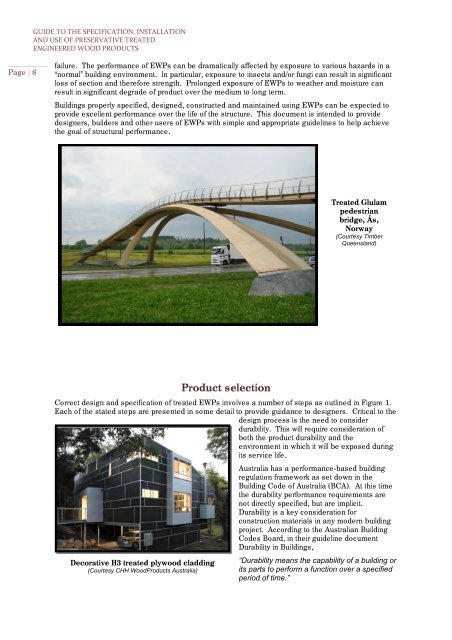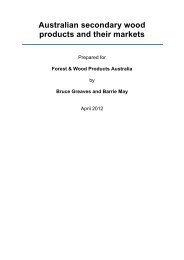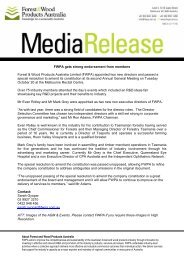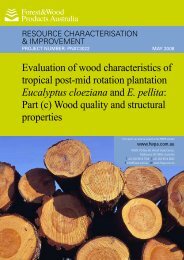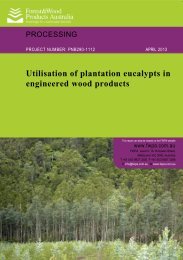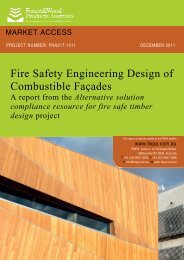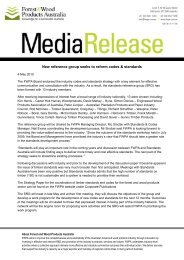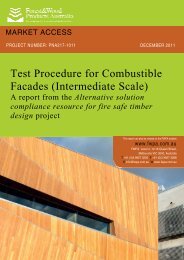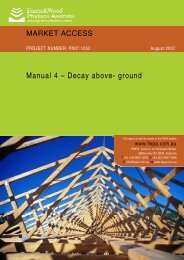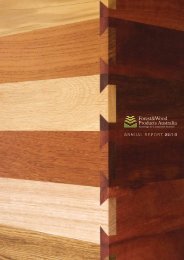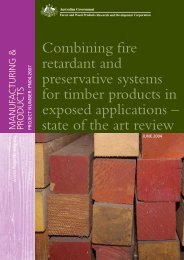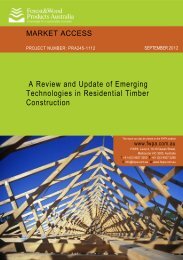guide to the specification, installation and use of preservative treated ...
guide to the specification, installation and use of preservative treated ...
guide to the specification, installation and use of preservative treated ...
You also want an ePaper? Increase the reach of your titles
YUMPU automatically turns print PDFs into web optimized ePapers that Google loves.
Page | 8<br />
GUIDE TO THE SPECIFICATION, INSTALLATION<br />
AND USE OF PRESERVATIVE TREATED<br />
ENGINEERED WOOD PRODUCTS<br />
failure. The performance <strong>of</strong> EWPs can be dramatically affected by exposure <strong>to</strong> various hazards in a<br />
“normal” building environment. In particular, exposure <strong>to</strong> insects <strong>and</strong>/or fungi can result in significant<br />
loss <strong>of</strong> section <strong>and</strong> <strong>the</strong>refore strength. Prolonged exposure <strong>of</strong> EWPs <strong>to</strong> wea<strong>the</strong>r <strong>and</strong> moisture can<br />
result in significant degrade <strong>of</strong> product over <strong>the</strong> medium <strong>to</strong> long term.<br />
Buildings properly specified, designed, constructed <strong>and</strong> maintained using EWPs can be expected <strong>to</strong><br />
provide excellent performance over <strong>the</strong> life <strong>of</strong> <strong>the</strong> structure. This document is intended <strong>to</strong> provide<br />
designers, builders <strong>and</strong> o<strong>the</strong>r <strong>use</strong>rs <strong>of</strong> EWPs with simple <strong>and</strong> appropriate <strong>guide</strong>lines <strong>to</strong> help achieve<br />
<strong>the</strong> goal <strong>of</strong> structural performance.<br />
Product selection<br />
Treated Glulam<br />
pedestrian<br />
bridge, Ås,<br />
Norway<br />
(Courtesy Timber<br />
Queensl<strong>and</strong>)<br />
Correct design <strong>and</strong> <strong>specification</strong> <strong>of</strong> <strong>treated</strong> EWPs involves a number <strong>of</strong> steps as outlined in Figure 1.<br />
Each <strong>of</strong> <strong>the</strong> stated steps are presented in some detail <strong>to</strong> provide guidance <strong>to</strong> designers. Critical <strong>to</strong> <strong>the</strong><br />
design process is <strong>the</strong> need <strong>to</strong> consider<br />
durability. This will require consideration <strong>of</strong><br />
both <strong>the</strong> product durability <strong>and</strong> <strong>the</strong><br />
environment in which it will be exposed during<br />
its service life.<br />
Decorative H3 <strong>treated</strong> plywood cladding<br />
(Courtesy CHH WoodProducts Australia)<br />
Australia has a performance-based building<br />
regulation framework as set down in <strong>the</strong><br />
Building Code <strong>of</strong> Australia (BCA). At this time<br />
<strong>the</strong> durability performance requirements are<br />
not directly specified, but are implicit.<br />
Durability is a key consideration for<br />
construction materials in any modern building<br />
project. According <strong>to</strong> <strong>the</strong> Australian Building<br />
Codes Board, in <strong>the</strong>ir <strong>guide</strong>line document<br />
Durability in Buildings,<br />
“Durability means <strong>the</strong> capability <strong>of</strong> a building or<br />
its parts <strong>to</strong> perform a function over a specified<br />
period <strong>of</strong> time.”


